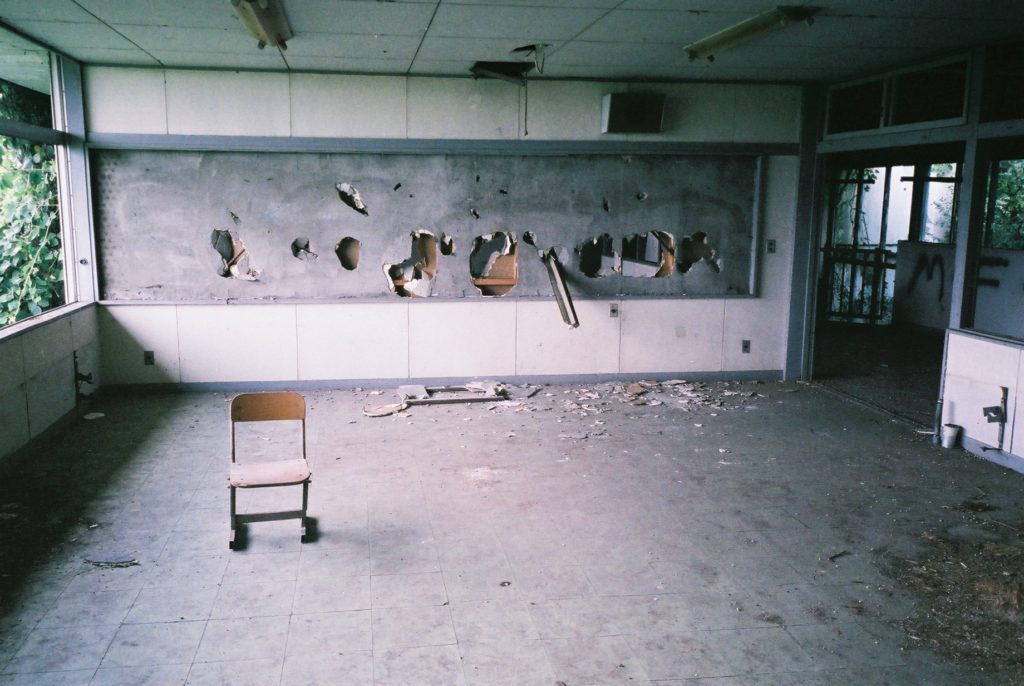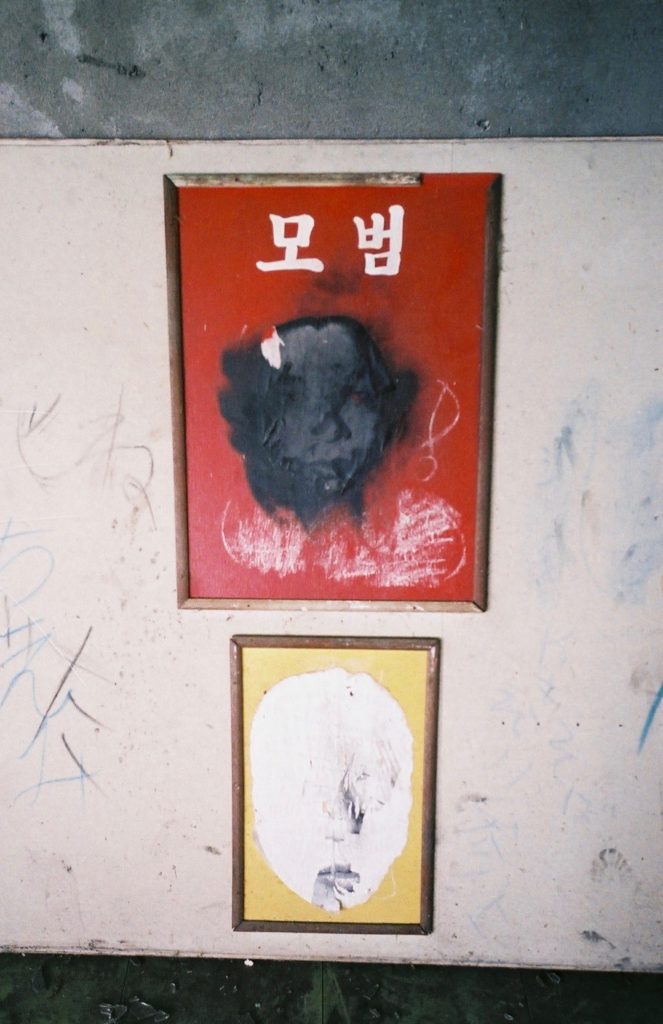Juche in Japan
Written and photographed by Ryan Berkebile
Dono Joseon Elementary and Middle School (도노조선초중급학교) sits upon a hill, offering a spectacular view of Toki, Japan. The school has been closed since 1998,[1] and now kudzu (Japanese arrowroot) is slowly enveloping the space. The invasive weed tangles itself in rusty playground equipment and leisurely engulfs the school building. The former auditorium has already become camouflaged, offering a preview of the main building’s fate.
This place is not a tourist destination in the traditional sense, but for me hopping on trains and buses to unknown rural locations is the ideal vacation. I am not the only one who enjoys searching for places forgotten by time. There is an international subculture of explorers who also enjoy searching for haikyo, the Japanese word for “ruins.” Type in “haikyo” or “urban exploration” into Google Search and you will find countless blogs devoted to the hobby. Many explorers have explored and documented Dono Joseon Elementary and Middle School throughout the years. With a captivated interest in all things North Korea and urban exploration, I knew I had to visit this former school – a school that was funded through the Dear Leader’s de facto embassy in Japan, The General Association of Korean Residents in Japan, or Chongryon (총련).

Before I share my exploration, please bear with me as I expand on my aesthetics of urban exploration. As the adage goes, “beauty is in the eye of the beholder.” Some might only see the wreckage of a structure. For me, seeing nature take over a space once occupied by humans is a thing of wonder. It is also a grounding reminder that humans are not the only beings that thrive on this planet. Countless species of flora and fauna reclaim the space as shelter. I have seen birds construct nests in corners of unused rooms and swarms of bees and their hives thrive in these conditions. Trees and plants remarkably find a way to grow through cracks in asphalt and concrete. Life in all forms can adapt to the environment it is placed in.
The ideal scenario is discovering a building that is completely forgotten – as if the people just walked away and never came back. Free of vandalism and litter, it provides a tiny glimpse into the last moments of human occupation. It is like coming across a time capsule; part of the fun is creating a reasonable narrative of the people who spent their lives there. From my experience, it is better to have low expectations when exploring a new space because then any artifact discovered would be a cause for fascination, and that is a win in my book. My only goal at this site was to find some evidence straight out of Pyongyang.

You might find yourself asking, “Why are there North Korean schools in Japan?” After the liberation of Korea from Japan and before the political division into North and South Korea, the Japanese government registered any permanent ethnic Korean resident in Japan, or jaeil gyopo (재일교포), a citizen of Joseon, the kingdom that ruled the Korean Peninsula prior to Japanese occupation. The government to this day does not recognize North Korea as a legitimate state on the Korean Peninsula. In 1965,[2] jaeil gyopo were given the opportunity to adopt South Korean or Japanese nationality. Anyone who identified as Joseon was automatically registered as North Korean.
As mentioned earlier, the Japanese government does not recognize North Korea as a true state. With no North Korean embassy in Japan, Joseon nationals living in Japan rely on Chongryon to provide support. Chongryon schools are taught in Korean with a curriculum furnished by the North Korean government. In the front of the classrooms hang honorary photos of Kim Il-sung and Kim Jong-il. In some classrooms, teachers and students wear traditional Korean clothing. Schools like these provide an opportunity for students to learn their mother tongue and form a sense of cultural identity even though they might not ever set foot in North Korea.

Entering the front gate, I realize this building will raise many questions yet offer few answers. All I can do is posit theories. Stepping into the school feels like reentering Korea. Hangeul (Korean alphabetic script) persists everywhere: in books, on receipts, and even on the chalkboard. Unresolved math equations dated September 1, 1997, have survived twenty years’ worth of vandalism. As I wander from classroom to classroom, I imagine students discussing the Eternal President’s ideology of self-reliance, or Juche (주체). If students wore traditional outfits at school, did they change out of them before departing to avoid alienation by locals?
Based on the evidence found, the first-floor classes were occupied by the elementary-aged students. Electric pink cubbies close to the ground are eye-catching despite the years of neglect. A child’s Mickey and Minnie Mouse toothbrush is the other indicator young children inhabited this space. Here students learned how to be ideal members of the Korean Children’s Union (조선소년단). Did these young ones don the red scarf to show allegiance to the Fatherland?

I might never get a chance to head to North Korea, but visiting this old school gave me tiny morsels that fed my imagination with what it means to be associated with the Democratic People’s Republic of Korea (DPRK) and the Kim family dynasty. Though I did not find any grandiose propaganda posters, I encountered artifacts such as Workers’ Party (조선로동당) books and a signboard that told me who was a teacher for second-year middle school students. I finally know that mobeom (모범) means “examplary” or “model” after coming across a defaced picture frame that at one time contained the faces of Kim Il-sung and Kim Jong-il, models of the proletariat par excellence. This exploration was my ideal vacation. Traversing the less-explored areas of a country is a great way to avoid the crowded frenzies of tourist traps while gaining insight at the same time.
[1] Seidel, F. (2012). North Korean School in Gifu/Chongryon School [Web log]. Retrieved from https://abandonedkansai.com/2012/01/05/north-korean-school-in-gifu-chongryon-school/
[2] Anonymous. (2013, July 1). Why Are There North Korean Schools in Japan? Retrieved from The Economist website: https://www.economist.com/the-economist-explains/2013/06/30/why-are-there-north-korean-schools-in-japan
THE AUTHOR
Ryan Berkebile is an English teacher, analog camera fanatic, and urban explorer living in Gwangju. He has been teaching in Korea since 2005 with brief stops in Vietnam and Japan along the way. Visit longdistancerunner.org or @zen_compass to see photos of his explorations.







